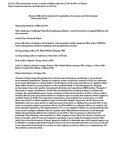Mostrar el registro sencillo del ítem
Watering or buffering? Runoff and sediment pollution control from furrow irrigated fields in arid environments
| dc.creator | Campo-Bescós, Miguel | es_ES |
| dc.creator | Muñoz Carpena, Rafael | es_ES |
| dc.creator | Kiker, Gregory A. | es_ES |
| dc.creator | Bodah, Brian W. | es_ES |
| dc.creator | Ullman, Jeffrey L. | es_ES |
| dc.date.accessioned | 2019-02-25T15:49:39Z | |
| dc.date.available | 2019-02-25T15:49:39Z | |
| dc.date.issued | 2015 | |
| dc.identifier.issn | 0167-8809 | |
| dc.identifier.uri | https://hdl.handle.net/2454/32411 | |
| dc.description.abstract | Surface irrigated agriculture in arid and semi-arid regions contributes to downstream environmental degradation. Changes in irrigation system operational scenarios (ISOS) can represent an economic alternative to reduce surface runoff impacts. At the same time the use of vegetative filter strips (VFS) can have a positive impact on the ecological health of rural landscapes by reducing erosion, improving water quality, increasing biodiversity, and expanding wildlife habitat. The goal of this paper is, using a combination of field data and mechanistic modeling results, to evaluate and compare the spatial effectiveness of improvements in ISOS and introduction of VFS to reduce surface runoff pollution in the semi-arid/arid furrow irrigation agroecosystem that exceeds current regulatory turbidity limits (25 NTU). Five main factor interactions were studied: four soil textures, two field slopes, three ISOS, six filter vegetation types, and ten filter lengths. Slope and runoff volume were identified as the two main drivers of sediment export from furrows. Shifting from current ISOS to less water consumptive irrigation practices reduce runoff in addition to sediment delivery to comply with environmental regulations. The implementation of 3 to 9 m vegetative buffers on experimental parcels were found to mitigate sediment delivery (greater than 90% sediment reduction) on tail drainage ditches but had limited effect in the reduction of runoff flow that can transport other dissolved pollutants. These findings were insensitive to filter vegetation type. Thus, introduction of improved ISOS is desirable while VFS may be targeted to specific hot spots within the irrigation district. This study shows that the adoption of dense vegetation buffers in vulnerable semi-arid irrigated regions can be effective to mitigate agricultural impacts and provide environmental protection. However, it should not be adopted as an alternative to proper on-site irrigation practices, rather as a complementary off-site pollution control practice. | en |
| dc.description.sponsorship | This study was funded through the USDA National Integrated Water Quality Program (NIWQP) under the grant entitled “Protecting Water Resources by Engaging Stakeholders in Targeted Implementation of Filter Strips” (Grant No. 2009-51130-06098). The authors wish to thank Elaine Brouillard (Roza-Sunnyside Board of Joint Control, Sunnyside, Washington) and R. Troy Peters (Washington State University)for their assistance in providing data and information on irrigation practices | en |
| dc.format.extent | 43 p. | |
| dc.format.mimetype | application/pdf | en |
| dc.language.iso | eng | en |
| dc.publisher | Elsevier | en |
| dc.relation.ispartof | Agriculture, Ecosystems & Environment, 205 (2015) 90–101 | en |
| dc.rights | © 2015 Elsevier B.V. This manuscript version is made available under the CC-BY-NC-ND 4.0 | en |
| dc.rights.uri | https://creativecommons.org/licenses/by-nc-nd/4.0/ | |
| dc.subject | Furrow irrigation | en |
| dc.subject | Rill irrigation | en |
| dc.subject | Total suspended solids | en |
| dc.subject | Vegetative filter strips | en |
| dc.subject | VFSMOD | en |
| dc.subject | Water management | en |
| dc.subject | Hotspots | en |
| dc.subject | Targeting | en |
| dc.subject | Best management practices | en |
| dc.title | Watering or buffering? Runoff and sediment pollution control from furrow irrigated fields in arid environments | en |
| dc.type | Artículo / Artikulua | es |
| dc.type | info:eu-repo/semantics/article | en |
| dc.contributor.department | Proyectos e Ingeniería Rural | es_ES |
| dc.contributor.department | Landa Ingeniaritza eta Proiektuak | eu |
| dc.rights.accessRights | Acceso abierto / Sarbide irekia | es |
| dc.rights.accessRights | info:eu-repo/semantics/openAccess | en |
| dc.identifier.doi | 10.1016/j.agee.2015.03.010 | |
| dc.relation.publisherversion | https://doi.org/10.1016/j.agee.2015.03.010 | |
| dc.type.version | Versión aceptada / Onetsi den bertsioa | es |
| dc.type.version | info:eu-repo/semantics/acceptedVersion | en |



